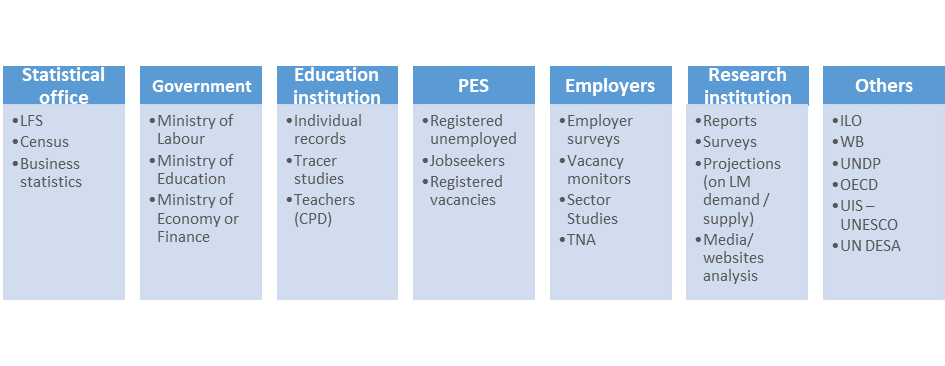A Labour Market Information System (LMIS) consists of all the institutional provisions, procedures and mechanisms set up to coordinate the collection, processing, storage, recovery and circulation of labour market information.
The main objective is to produce labour market analyses that provide input for the formulation and implementation of employment policies, projects and programmes to promote employment. An LMIS also informs education policy, and other policies, by supplying information on the demand, supply and mismatch of skills so that education and training systems may be adapted or reformed to better address mismatches and respond to the needs of the labour market.
To meet these objectives, the system must be able to:
- Provide relevant and reliable information on employment and labour migration, both nationally and in administrative subdivisions: the collection and compilation of data;
- Analyse the labour market by highlighting signals of trends: analytical capacity and tools;
- Provide a decision-making assistance tool by contributing to the definition, assessment and improvement of labour, training and labour migration policies, and by promoting social dialogue between partners: institutional arrangements and networks.
LMIS main functions and components

Advanced Labour Market Information System elements:
- Several interconnected subsidiary information systems;
- Public interfaces of subsidiary systems tailored to different types of users (policy-makers, employment services, counselling and guidance services, education and training providers, students, workers and jobseekers, employers, researchers);
- A well-developed public job matching component;
- Detailed information at the local level;
- Effective partnerships which underpin governance issues.
Logical steps to build an LMIS
Step 0: Building a conducive institutional setting
Setting up and running a Labour Market Information System is a task that needs to be performed in partnership with many stakeholders, as data and information come from different sources and effective cooperation is crucial. The process of developing an LMIS should be carefully planned and designed as a sustainable activity. In order to be successful, the whole process needs to be supported by a coordinated institutional framework involving all the key stakeholders.
Step 1: Formulating the aims
Objectives may include employment, education and economy- or industry-related aspects. They should determine at which level the analysis has to be performed (national, regional or sectoral), the time frame (short, medium or long term), the required data and the regularity of updates.
Step 2: Data audit
In each country there are various data sources and a data audit should be conducted to decide which data sources are the most useful for monitoring and anticipating skills supply and demand. The data audit may also reveal significant information gaps, suggesting the need to improve existing data collection tools or develop new ones.
Step 3: Capacity building
The use of an LMI requires having the infrastructure for the collection, analysis and dissemination of data, as well as trained and experienced analysts who are able to work with the data. Such capacity building should include improving the statistical infrastructure, training analysts and other staff in the relevant institutions, and building the trust of respondents and data users through data protection regulations.
Step 4: Analysis
This includes choosing the relevant methods, formulating the research questions, data analysis, and interpretation and validation of the results.
Step 5: Dissemination and use of information
The main purpose of data collection and analysis is to provide labour market actors with information they can use in decision-making to solve mismatch problems.
What type of information can an LMIS provide?
Different data sources that contribute to the system
|
Data source |
Strengths |
Weaknesses |
|
Labour Force Surveys |
|
|
|
Public Employment Service statistics |
|
|
|
Enterprise statistics |
|
|
|
Employers surveys |
|
|
|
Tracer studies |
|
|
|
Qualitative data sources |
|
|
|
Projections |
|
|
Other relevant quantitative data sources:
- Population censuses;
- Household surveys other than LFS;
- Public employment service (PES) statistics on vacancies and jobseekers;
- Education statistics;
- Administrative data on tax, social insurance, etc.;
- Skill-specific data sources;
- Big data, including analysis of job/vacancies portals.
Typical data gaps and challenges:
- Data not collected or not fully compliant with international standards (e.g. ILO standards for LFS);
- Problems with data sharing among institutions (e.g. privacy protection laws; weak inter-institutional cooperation);
- Information and data available but under-utilised or not used (e.g. LFS data not fully used to monitor LM trends);
- Dissemination of information and following up on trends;
- Time lags in incorporating the results into policies, weak response from education/training systems;
- Lack of continuity or ad hoc surveys which are not embedded in the system;
- Problems in presenting the results in a structured way that is relevant and understandable for the end users.
Labour Market Information actors:
The system requires an appropriate institutional setting with clearly defined roles and responsibilities, and which is also equipped with sufficient resources to implement them. Institutional arrangements may vary based on the country context; however, the active involvement and collaboration of various stakeholders, including social partners, are a precondition for establishing an efficient and well-functioning LMIS. This creates a culture of joint responsibility, which promotes long-term commitment to problem-solving and ensures a greater harmonisation of skills development policies. The most important actors in an LMIS are:

Success factors:
- Good quality data: regular, reliable, comparable and accessible;
- Use of different data sources and understanding the limitations of each source;
- Strong analytical capacity and continuity in data analyses;
- Inter-institutional ownership and active cooperation on data sharing;
- Producing information that is relevant to the needs of users, presented in a clear and simple way that is understandable to end-users;
- Effective dissemination of results and regular interaction with the users of the information (feedback mechanism);
- Appropriate use of the results in decision-making and Human Capital Development policy implementation.
